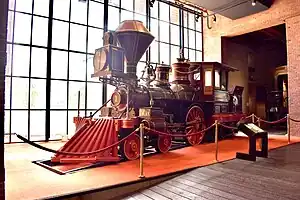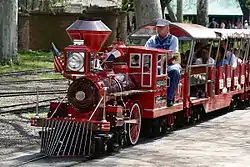C. P. Huntington
C. P. Huntington is a 4-2-4T steam locomotive on static display at the California State Railroad Museum in Sacramento, California, USA. It is the first locomotive purchased by the Southern Pacific Railroad, carrying that railroad's number 1, and it is named after one of the Big Four who founded it.
| C. P. Huntington | |||||||||||||||||||||||||||
|---|---|---|---|---|---|---|---|---|---|---|---|---|---|---|---|---|---|---|---|---|---|---|---|---|---|---|---|
 The C.P. Huntington at the California State Railroad Museum | |||||||||||||||||||||||||||
| |||||||||||||||||||||||||||
| |||||||||||||||||||||||||||
| |||||||||||||||||||||||||||
| |||||||||||||||||||||||||||
History and career

C. P. Huntington was originally purchased by Central Pacific Railroad (CP) in 1863 as that railroad's number 3, along with its sister engine T. D. Judah (CP no. 4). It was CP's third locomotive after Gov. Stanford (number 1, built by Norris Locomotive Works) and Pacific (number 2, built by Mason Machine Works). The locomotive is named in honor of Collis P. Huntington, the third president of the Southern Pacific Company (parent company of Southern Pacific Railroad).[1] CP used the locomotive beginning on April 15, 1864, during construction of the western portion of the First transcontinental railroad in North America.
Southern Pacific (SP) purchased C. P. Huntington from CP on February 5, 1871, gave it their number 1, and used it in light service in northern California. It was rebuilt twice, first in 1873 with new valves and again in 1888 with a new boiler built by CP's Sacramento shops. In 1888 the locomotive was also put on public display for the first time in Sacramento.
In SP's 1891 renumbering plan, C. P. Huntington was assigned road number 1001. The locomotive was placed in storage for some time until it was rebuilt for use as a lineside weed burner in 1901. Its use as a weed burner proved unsatisfactory and the locomotive was again removed from active service. In 1910, C. P. Huntington was again rebuilt and it was then kept at SP's machine shops where it remained for a few years. The locomotive was nearly scrapped in 1914; it was spared this fate by SP management so that it could be displayed at the Panama–Pacific International Exposition in 1915 after a cosmetic restoration.
On May 3, 1939, C. P. Huntington participated in the grand opening ceremonies for the Los Angeles Union Station. Operating under her own steam, the Huntington was paraded past large, cheering crowds to the newly completed passenger terminal, along with several other engines, including the famous 4-4-0, Virginia & Truckee 22, the Inyo (still painted in Union Pacific livery, from the filming of Cecil B. DeMille's 1939 movie of the same name, which premiered two days later), and Southern Pacific 4120, a massive AC-5 class 4-8-8-2 cab forward. The moment was captured on film by Disney animator and lifelong train enthusiast, Ward Kimball, and may be some of the only known footage of the engine under steam.[2]
Southern Pacific donated the engine to the State of California in 1964. The locomotive was placed on display at the old state fairgrounds on Stockton Boulevard, in Sacramento, where it remained until a 1970 refurbishing at Southern Pacific's Sacramento Shops, when it was placed in the Central Pacific Railroad Passenger Station in Old Sacramento in 1979. In 1981 it was moved into the newly opened California State Railroad Museum, where it now remains on static display.[3][4]
Working replicas

Chance Rides began to fabricate their 2 ft (610 mm) narrow gauge[5] C. P. Huntington locomotive in 1960. Since 2018, these locomotives can be powered by gas, diesel, propane or electric engines. Its drive wheels are not powered, but roll on the rails while fake side rods reciprocate in and out of fake cylinders. Power is instead provided by the front and rear trucks. Some owners have chosen to remove the false drive wheels for ease of maintenance.
With over 400 examples built as of 2022, the C. P. Huntington has become the most popular park train since the Allan Herschell Company merged into Chance Industries in 1970 and production of the S-24 Iron Horse train ceased. Many parks have replaced their steam locomotives with C. P. Huntington locomotives since they are easier to maintain and operate.[6] Locomotives and coaches can be customized in a variety of ways.
Working replicas of the C. P. Huntington are manufactured by Western Train Co. (formerly Katiland Trains), which also converts older C. P. Huntington locomotives to hydrostatic diesel power.[7]
In popular culture
The unique design of the C. P. Huntington inspired the appearance of The Little Engine That Could in most storybook renderings.[8][9]
References
- Diebert, Timothy S.; Strapac, Joseph A. (1987). Southern Pacific Company Steam Locomotive Conpendium. Shade Tree Books. ISBN 0-930742-12-5.
- Academy of Motion Picture Arts and Sciences, Kimball Family Collection
- "C.P. Huntington". CA State Parks. Retrieved 2019-04-17.
- "Exhibits - California State Railroad Museum". www.californiarailroad.museum. Retrieved 2019-04-17.
- Chance Rides C. P. Huntington Train Specs
- "C. P. Huntington | Train & Theme Park History". The Abandoned Carousel. 2019-09-04. Retrieved 2020-10-08.
- "Train conversions available". 13 May 2019.
- "I think I can. I think I can. - Original 1906 cover". 19 July 2010.
- "The Little Engine That Could, Watty Piper, 1954 - yellow cloth cover with black print". Archived from the original on 2012-04-26. Retrieved 2018-06-09.
External links
![]() Media related to C. P. Huntington (locomotive) at Wikimedia Commons
Media related to C. P. Huntington (locomotive) at Wikimedia Commons